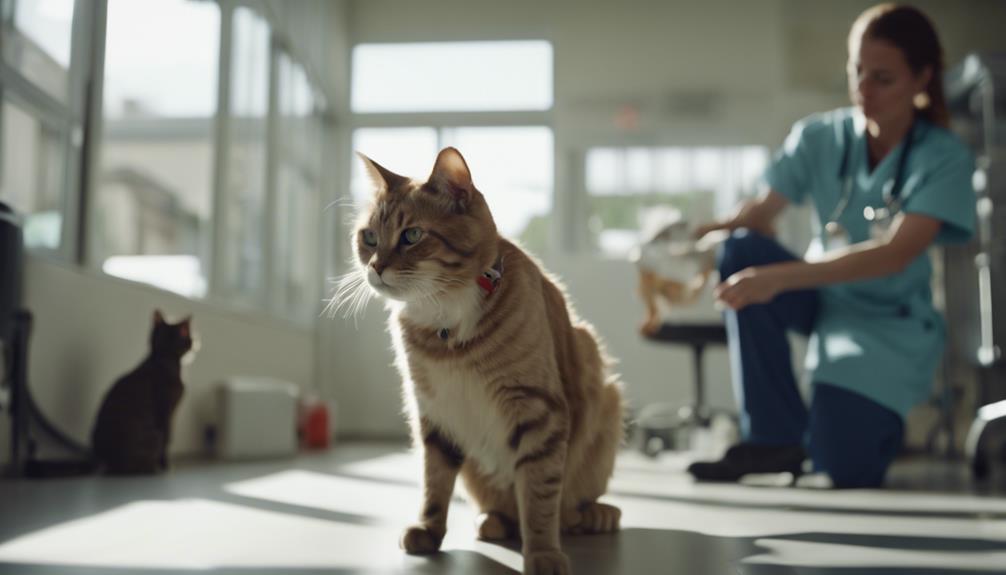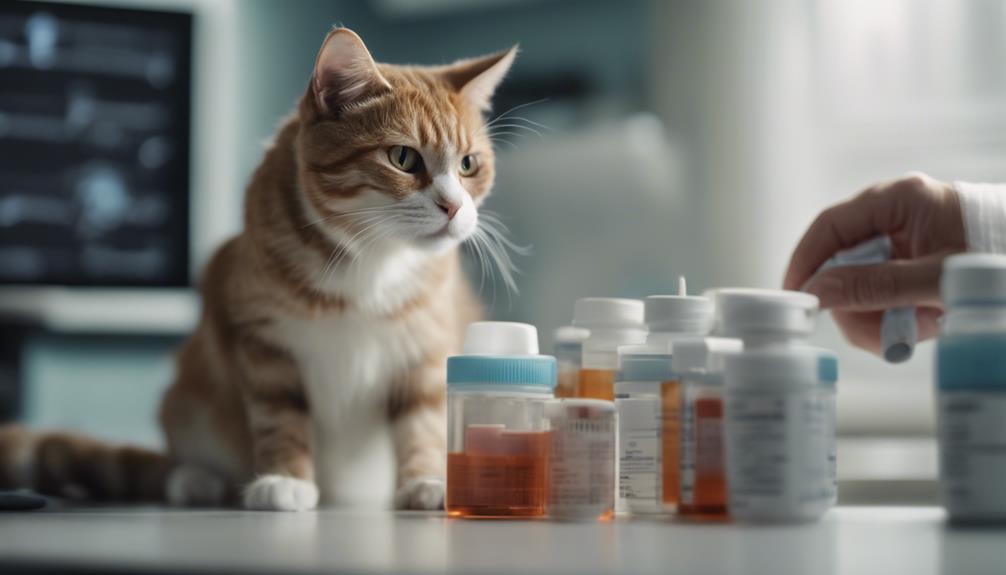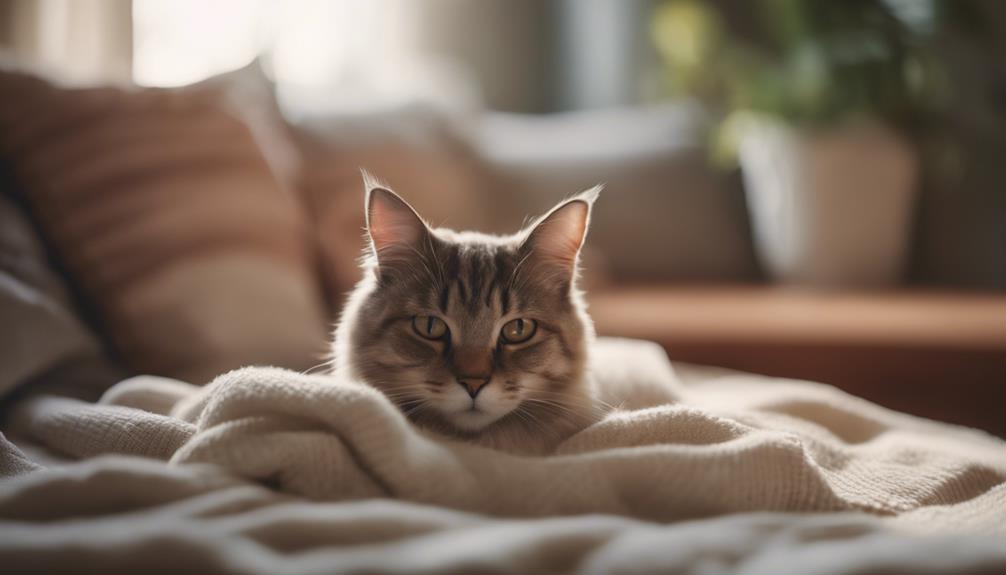Congestive heart failure in cats is a grave concern for many pet owners, as the potential implications can be severe. The subtle signs and symptoms that may indicate a problem often go unnoticed until the condition progresses.
Understanding the gravity of heart issues in felines is crucial for prompt intervention and management. In this discussion, we will explore the red flags to look out for, the steps to take in case of suspected heart failure, and the vital role of early detection in ensuring the well-being of our feline companions.
Key Takeaways
- Recognize symptoms like breathing difficulties and sudden hind leg paralysis in your cat.
- Seek immediate veterinary attention for a proper diagnosis and treatment plan.
- Understand that heart failure in cats is progressive but can be managed for improved quality of life.
- Regular veterinary checkups are crucial for early detection and effective management of feline heart conditions.
Recognizing Symptoms of Heart Failure
When observing cats for signs of congestive heart failure, recognizing the symptoms early is crucial for prompt veterinary intervention and management. Symptoms of congestive heart failure in cats include decreased activity, breathing difficulties, sudden hind leg paralysis, decreased appetite, and weight loss.
Additionally, cats may exhibit difficulty lying down, sudden collapse, rapid breathing, and a distended belly due to fluid buildup. If your cat shows these signs, immediate veterinary attention is necessary, particularly in cases of acute distress or hind limb paralysis.
Diagnosis typically involves radiographs, heart ultrasound, and EKG to assess the condition accurately. Treatment options may include oxygen therapy, diuretics, anticoagulants, and medications to support heart function and manage heart failure effectively.
Early detection and proper management are essential for improving the quality of life and lifespan of cats with heart conditions.
Understanding Causes and Risk Factors
Understanding the underlying causes and associated risk factors of congestive heart failure in cats is paramount in effectively managing this condition and ensuring optimal outcomes for feline patients.
- Cardiomyopathies: Cardiomyopathies, particularly hypertrophic cardiomyopathy, are the primary causes of congestive heart failure in cats.
- Genetic Predisposition: Certain cat breeds like Maine Coons and Persians have a genetic predisposition to heart issues, increasing their risk of developing heart failure.
- Contributing Factors: Other contributing factors include conditions like hyperthyroidism, high blood pressure, and heartworm disease, which can exacerbate heart problems in cats.
Seeking Immediate Veterinary Attention

Promptly seeking veterinary care is crucial when a cat shows signs of acute distress or hind limb paralysis related to congestive heart failure. These symptoms can indicate a severe exacerbation of the condition requiring immediate attention.
Upon arrival at the veterinary clinic, the cat will undergo a thorough examination to assess its current state. Diagnostic tests such as radiographs, heart ultrasound, and EKG may be performed to evaluate the extent of heart failure and determine the best course of treatment.
In cases of acute distress, oxygen therapy and medications to alleviate symptoms may be administered promptly. Early intervention in these critical situations can significantly impact the cat's prognosis and quality of life.
Diagnosing Feline Heart Disease
Seeking immediate veterinary attention for a cat displaying signs of acute distress or hind limb paralysis associated with congestive heart failure is crucial. Once at the veterinary clinic, diagnostic procedures like radiographs and heart ultrasound are conducted to diagnose feline heart disease. These tests provide valuable information about the cat's heart condition, enabling veterinarians to tailor treatment plans effectively.
The following are key diagnostic steps in diagnosing feline heart disease:
- Radiographs: X-rays of the chest can reveal changes in heart size, shape, and the presence of fluid in the lungs.
- Heart Ultrasound: Also known as echocardiography, this non-invasive imaging technique allows for a detailed assessment of the heart's structure and function.
- Electrocardiogram (EKG): This test records the electrical activity of the heart, helping identify abnormal heart rhythms and conduction abnormalities.
Implementing Treatment and Care Plan

For effective management of cat congestive heart failure, a comprehensive treatment and care plan tailored to the individual feline patient's needs is essential. This plan typically involves a combination of medications, dietary management, and lifestyle modifications to improve the quality of life and slow disease progression. Below is a table outlining some key components commonly included in a treatment and care plan for cats with congestive heart failure:
| Treatment Component | Description | Purpose | Frequency |
|---|---|---|---|
| Medication | Diuretics, ACE Inhibitors, Beta-blockers | Manage symptoms, improve heart function | Daily |
| Diet Management | Low-sodium diet | Reduce fluid retention and strain on the heart | Ongoing |
| Monitoring | Regular vet check-ups, weight monitoring | Track progress, adjust treatment as needed | Every 3-6 months |
| Lifestyle Modifications | Reduced stress, limited activity | Minimize heart workload, enhance well-being | Daily |
Managing Prognosis and Expectations
To effectively navigate the management of cat congestive heart failure, understanding the prognosis and setting realistic expectations is paramount for ensuring the best possible care for feline patients.
When dealing with this serious condition, here are key points to consider:
- Progressive Nature: Congestive heart failure in cats is a progressive and incurable disease that requires ongoing management.
- Life Expectancy: Most cats diagnosed with congestive heart failure have a life expectancy of 6 to 12 months, with proper treatment and care.
- Quality of Life: Early detection, timely intervention, and appropriate treatment can significantly enhance the quality of life and lifespan of cats affected by heart conditions.
Providing Supportive Environment for Recovery

Creating a nurturing environment is essential for the recovery and well-being of cats with congestive heart failure. This supportive setting can significantly impact their comfort and quality of life. Here are key elements to consider in providing a conducive environment for your feline companion:
| Environmental Factor | Recommendation | Purpose |
|---|---|---|
| Temperature Control | Maintain a moderate temperature in the living area, avoiding extreme heat or cold. | Helps reduce stress on the cat's heart and promotes comfort. |
| Low-Stress Environment | Minimize loud noises and create a calm space with familiar bedding and toys. | Reduces anxiety levels and aids in relaxation, crucial for heart health. |
| Proper Hydration | Ensure easy access to fresh water sources to prevent dehydration. | Hydration supports heart function and overall well-being. |
Frequently Asked Questions
Are There Any Alternative or Holistic Treatment Options Available for Cats With Congestive Heart Failure?
While there are alternative and holistic treatments explored for various conditions, in congestive heart failure cases in cats, immediate veterinary attention and conventional medical interventions like diuretics, medications, and supportive care are crucial.
Can Congestive Heart Failure in Cats Be Prevented Through Diet and Lifestyle Changes?
While diet and lifestyle changes can support overall feline health, congenital causes like cardiomyopathies often underlie congestive heart failure in cats. Regular veterinary monitoring, early detection, and appropriate medical management are key preventive measures.
Is There a Specific Age Range at Which Cats Are More Likely to Develop Heart Failure?
Cats are more likely to develop heart failure as they age, with senior felines being at higher risk. While there isn't a specific age range universally applicable, vigilance and regular veterinary checkups become crucial for early detection and management.
Are There Any Warning Signs or Behaviors That May Indicate a Cat Is at Higher Risk for Heart Failure?
Warning signs of potential heart failure risk in cats include decreased activity, breathing difficulties, sudden hind leg paralysis, decreased appetite, and weight loss. Early detection through veterinary checkups is crucial for timely intervention and improved outcomes.
How Can Cat Owners Best Monitor and Track Their Pet's Heart Health at Home Between Veterinary Checkups?
Cat owners can monitor their pet's heart health at home by observing for changes in breathing, activity levels, and appetite. Regularly check for sudden weight loss, hind leg weakness, or unusual behaviors. Consult a veterinarian promptly with any concerns for proper evaluation and guidance.
What to Do if You Suspect Your Cat Has Dementia and Heart Failure?
If you notice your cat exhibiting unusual behavior such as disorientation, forgetfulness, or changes in appetite and sleep patterns, it could be cat dementia symptoms and signs. Additionally, if you suspect your cat may have heart failure, look for symptoms such as difficulty breathing, coughing, or lethargy. Consult a veterinarian immediately for proper diagnosis and treatment.
Conclusion
In conclusion, congestive heart failure in cats is a serious condition that requires prompt recognition and intervention. By understanding the symptoms, causes, and treatment options for feline heart disease, pet owners can provide essential care and support to their beloved companions.
Seeking immediate veterinary attention, implementing a comprehensive care plan, and creating a supportive environment for recovery are crucial steps in managing this potentially life-threatening condition. Vigilant veterinary care and proactive measures are essential in navigating the challenges of congestive heart failure in cats.




